

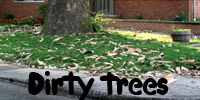
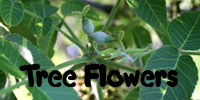
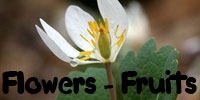
(Additional content at flickr Photostream and YouTube Channel)
If you have botany questions or comments please email BobK . Thanks!
Canada brome, Bromus pubescens
June 15, 2010. Wyandot County, Ohio
The grass genus Bromus
(variously called "brome," "chess," and "cheat") is a fairly
distinctive one, striking by virture of its large, narrow,
many-flowered spikelets arranged in lax open panicles. The most common
brome grasses are introduced weeds. An annual called cheatgrass, Bromus tectorum,
for instance, is one of the most noxious weeds of western pasture land.
Therefore it was a special treat to finally meet a native brome growing
alongside the Marion-Wyandot County Road, on the Wyandot side. It's
Canada brome, Bromus pubescens
(formerly called B. purgans)
--a tall perennial of moist woods.
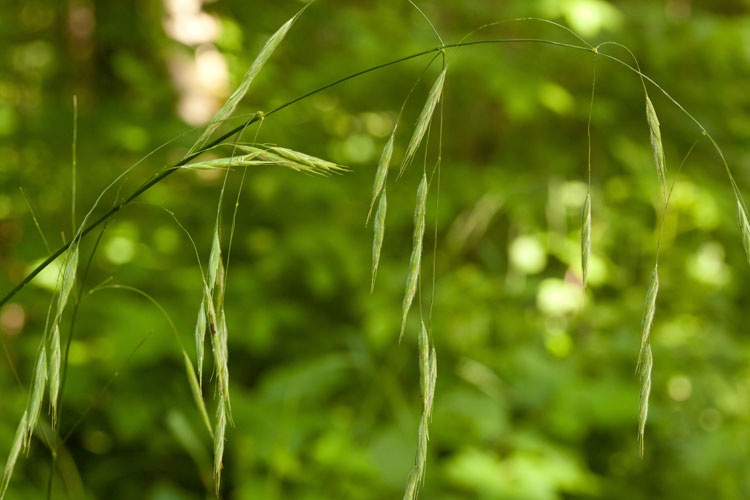
Canada brome. June 15, 2010. Wyandot County, Ohio.

Canada brome. June 15, 2010. Wyandot County, Ohio.
As seen here, the spikelets
are generally pubescent. Note also the lemmas are awned, as is often
the case with brome grasses, although in this species the awns are
shorter than in many other bromes, and according to the manuals, the
awns may be lacking entirely.
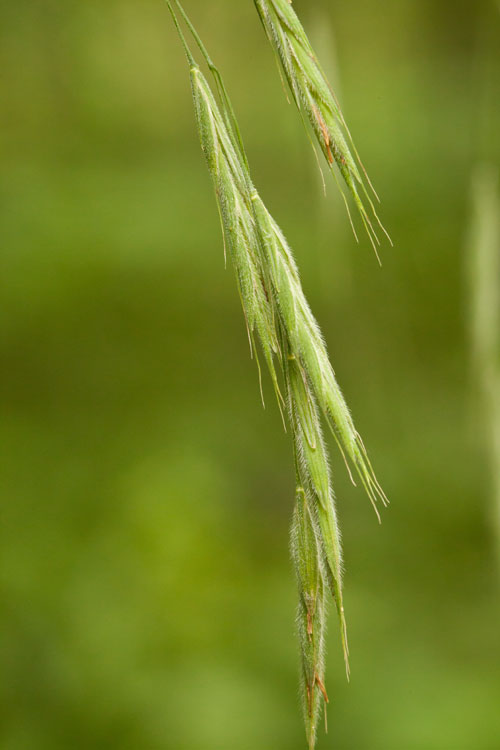
Canada brome spikelets. June 15, 2010. Wyandot County, Ohio.

Canada brome spikelets. June 15, 2010. Wyandot County, Ohio.
An Unusual Moss with Distinctive Gemmae.
Orthotrichum obtusifolium
June 13, 2010. Delaware County, Ohio.
I was there looking for
lichens and also to snap some pics of Anomodon
minor
(see below). Leaning across a little intermittent tributary stream to
the Scioto River running through the rich woodland here, is a leaning
hardwood sapling, perhaps an elm.
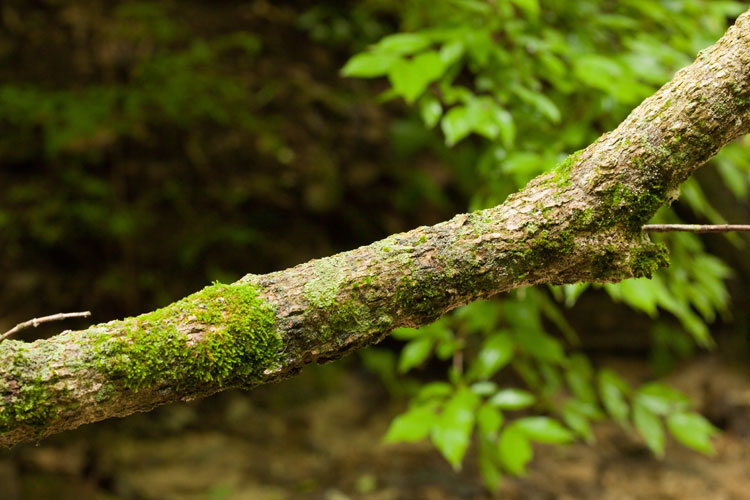
Leaning tree, habitat for lichens and mosses.

Leaning tree, habitat for lichens and mosses.
The lichens turned out to be Phaeophyscia ciliata and Physcia stellaris.
They were nice to see, although both species are quite common. It was
also clear that, sharing the log with the lichens, there are sterile
(i.e., lacking sporophytes) individuals of a common corticolous moss
genus: Orthotrichum. There
are 10 species of Orthotrichum
in Ohio, and identification to species is tough even if you have
compete specimens with capsules. But a close look at the Orthotrichum
tufts revealed them to be of two types: one with acute leaves that
could be any of several annoying species, and others that are
distinctly blunt tipped.
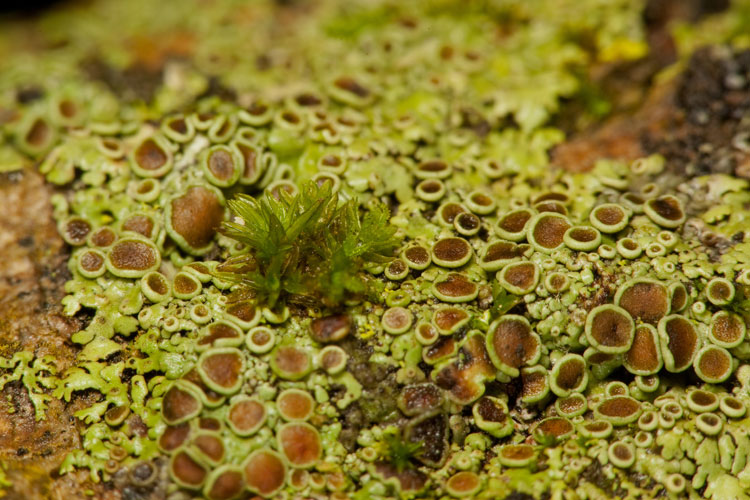
Two lichens, and two mosses close together, on a branch.
Phaeophyscia ciliata is the sparse brownish lichen in the lower left.
Physcia stellaris is the abundant lichen, bearing apothecia.
The mosses are Orthotrichum species --one a mystery, the other shown below.

Two lichens, and two mosses close together, on a branch.
Phaeophyscia ciliata is the sparse brownish lichen in the lower left.
Physcia stellaris is the abundant lichen, bearing apothecia.
The mosses are Orthotrichum species --one a mystery, the other shown below.
Moreover the blunt-tipped
ones looked all porcupiney (yay, no
spell-checker!) because the leaves are beset with elongate 4 to
8-celled asexual reproductive structures called "gemmae."
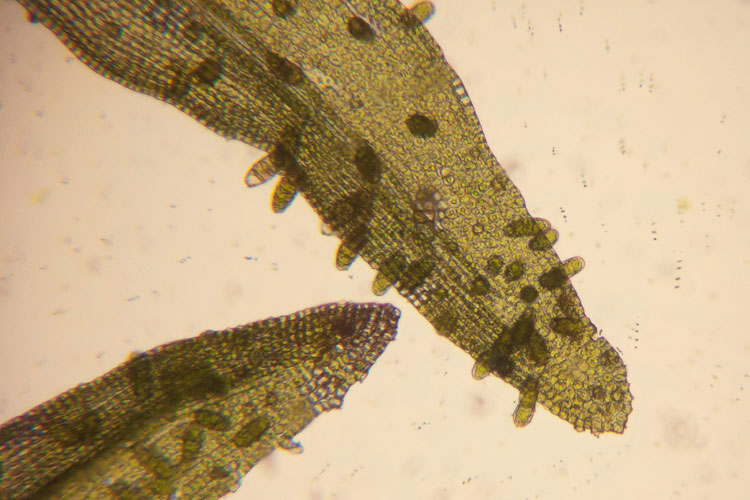
Orthotrichum obtusifolium microscope view.
Note blunt leaves and abundant gemmae on the leaf surface.

Orthotrichum obtusifolium microscope view.
Note blunt leaves and abundant gemmae on the leaf surface.
Orthotrichum
obtusifolium is
quite an uncommon, or at least uncommonly detected, moss in Ohio. The
range map in the Ohio Biological Survey's "Catalogue and Atlas of the
Mosses of Ohio" (1996, Andreas and Snider, revised, March 2010) only
shows 6 counties. Delaware County, marked by a weird purple
asterisk, is not one of them, yet.
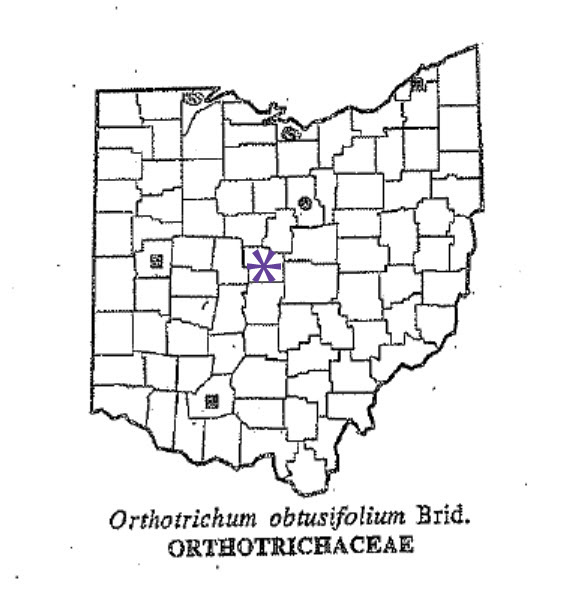
Range map from "Catalogue and Atlas of the Mosses of Ohio."

Range map from "Catalogue and Atlas of the Mosses of Ohio."
Anomodon minor
June 13, 2010.
Delaware County, Ohio.
The moss genus Anomodon
is notable for being one of the few mosses for which different species
of a single genus can often be seen growing in mixed patches. There is
nonetheless some differentiation of habitat. One of our most abundant
and distinctive mosses is Anomodon
attentuatus,
which can often be seen in open woods clothing the bases of hardwood
trees like a ragged green ankle sock. Here it is a few years ago at
Deep Woods Preserve in Hocking County, Ohio.
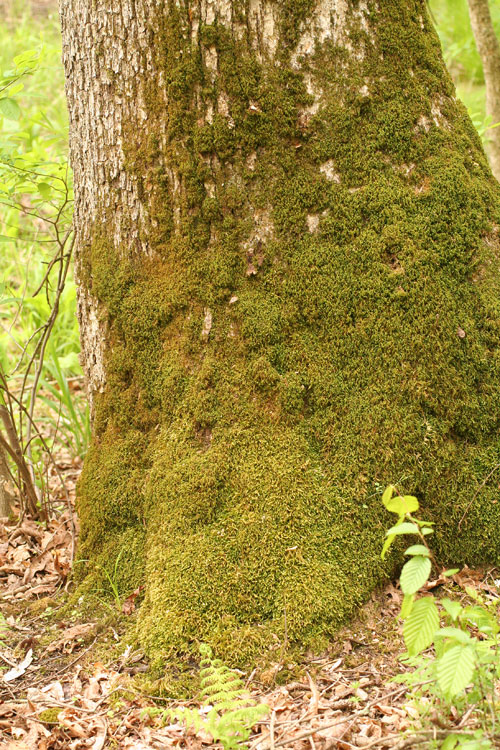
Anomodon attenuatus at base of tree.
Deep Woods, Hocking Cty. OH. May 7, 2008.
Bulblet Fern and Orchard Spider
Anomodon attenuatus at base of tree.
Deep Woods, Hocking Cty. OH. May 7, 2008.
A closer view shows us the
basis for the specific epithet attenuatus,
as the leaves get smaller towards the branch tips, each somewhat
flattened branch tapering nearly to a point. Here what it looks like
when wet.
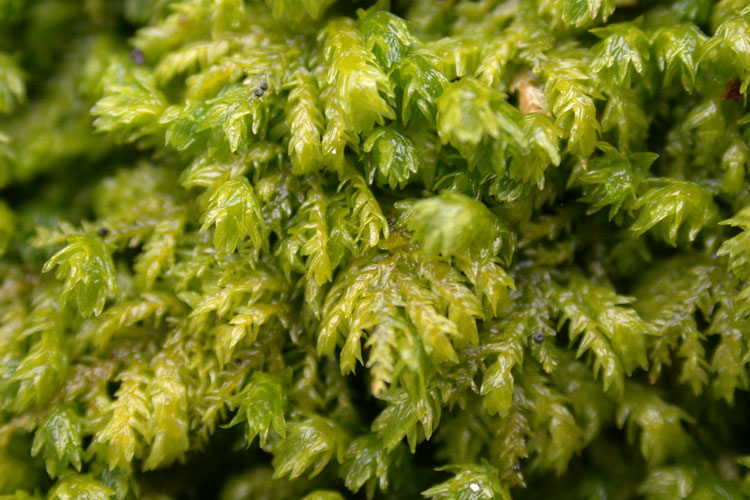
Anomodon attentuatus. February 14, 2005. Deep Woods Preserve.

Anomodon attentuatus. February 14, 2005. Deep Woods Preserve.
...and here's Anomodon attenuatus dry and
somewhat curled up, seen with the dog lichen, Peltigera canina on a sandstone
boulder.
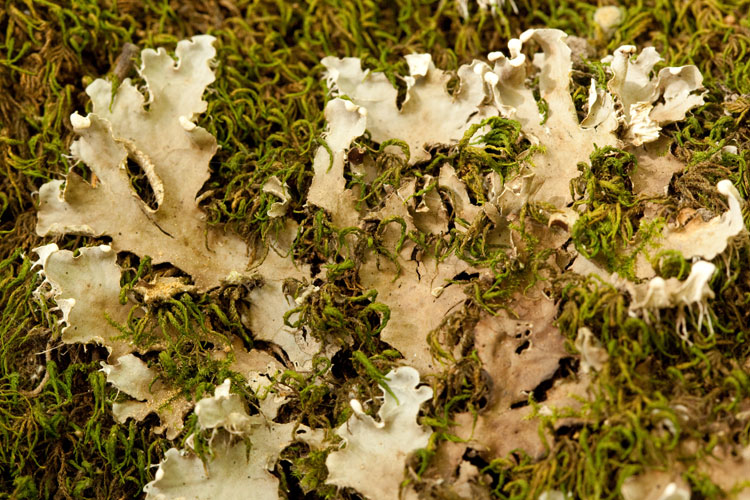
Anomodon attentuatus with dog lichen.
Shade River State Forest. Meigs County, Ohio. September 19, 2009.

Anomodon attentuatus with dog lichen.
Shade River State Forest. Meigs County, Ohio. September 19, 2009.
Microscopically, the leaves
of A. attenuatus are
distinctive. They are broadly tongue-shaped.
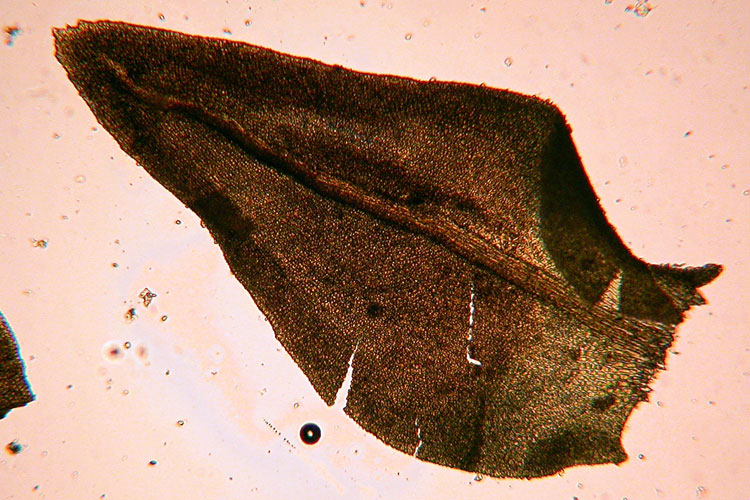
Anomodon attenuatus leaf.

Anomodon attenuatus leaf.
...with tips that are acute,
and marked by a few irregular teeth, and cells that are
"pluripapillose," i.e., beset with many small bumps.
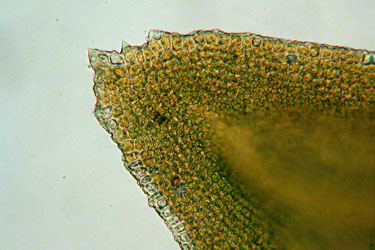
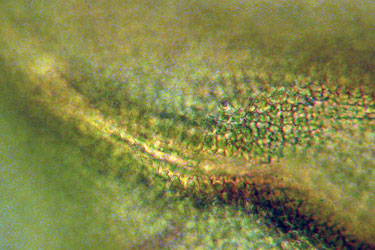
Leaf features of Anomodon attenuatus.
Left: serrate tip. Right: papillose cells.


Leaf features of Anomodon attenuatus.
Left: serrate tip. Right: papillose cells.
Another common species is Anomodon rostratus. While this may
often be seen with its just-described congener at the bases of trees, A. rostratus
seems a little more at home on moist partly shaded rock ledges,
seemingly without regard for chemistry, occurring both on basic
limestone and acidic sandstone. Here it is on limestone along the
Scioto River in Franklin County.
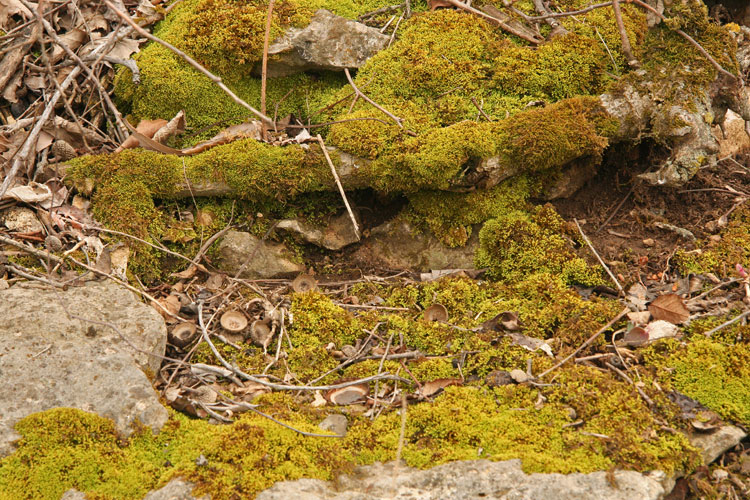
Anomodon rostratus carpets limestone ledge along Scioto River.
Franklin County, Ohio. March 17, 2008.

Anomodon rostratus carpets limestone ledge along Scioto River.
Franklin County, Ohio. March 17, 2008.
Close-up, we see a feature of
Anomodon rostratus
that clearly differentiates it from other members of the genus. The
leaves are arrayed regularly around the branches, giving them a tubular
appearance, like a cat's tail. The techno-mossy term for that is
"julaceous." The yellowish color is distinctive, too.
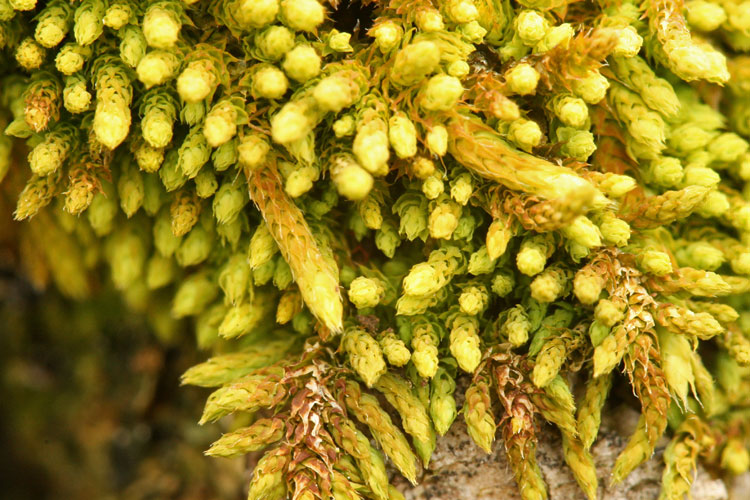
Anomodon rostratus. March 17, 2008. Franklin County, Ohio.
Again, the microscope is useful for confirming the identification. The leaves of Anomodon rostratus end in a beak-like hair-point.
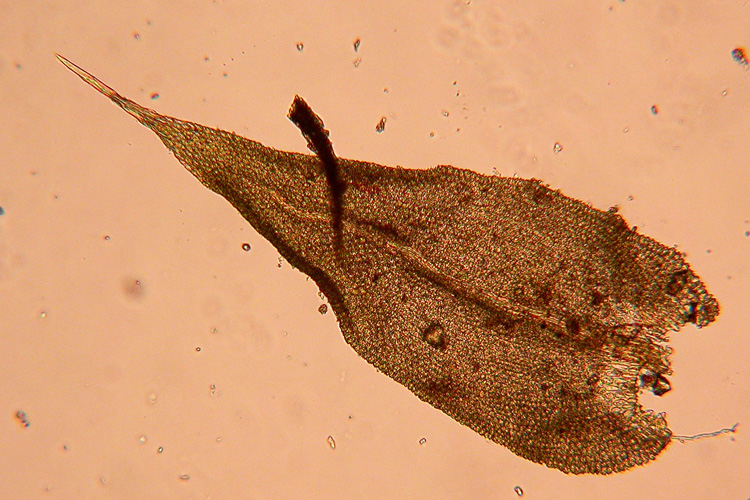
Anomodon rostratus leaf.

Anomodon rostratus. March 17, 2008. Franklin County, Ohio.
Again, the microscope is useful for confirming the identification. The leaves of Anomodon rostratus end in a beak-like hair-point.

Anomodon rostratus leaf.
The big excitement, and why
we're talking about Anomodon
today, is that in a rich open woods alongside the Scioto River in
Delaware County, there is a another, less common but by no means rare
species, Anomodon minor.
Fairly robust, having flattened branches, and occurring often on trees,
this can be, and probably often is, overlooked because it resembles A. attenuatus. It seems to be more
of a high-bark species though.
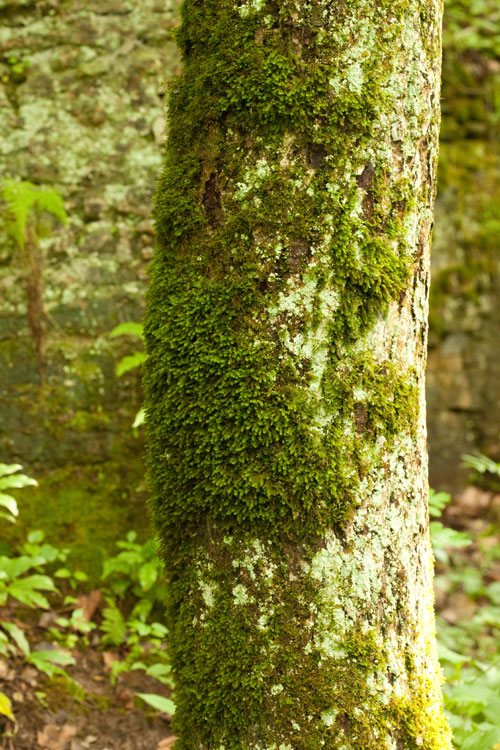
Anomodon minor high on bark of hardwood tree in rich woods.
June 9, 2010. Delaware County, Ohio.

Anomodon minor high on bark of hardwood tree in rich woods.
June 9, 2010. Delaware County, Ohio.
Compared with A. attenuatus, Anomodon minor
branches project out more, in a shelf-like fashion.
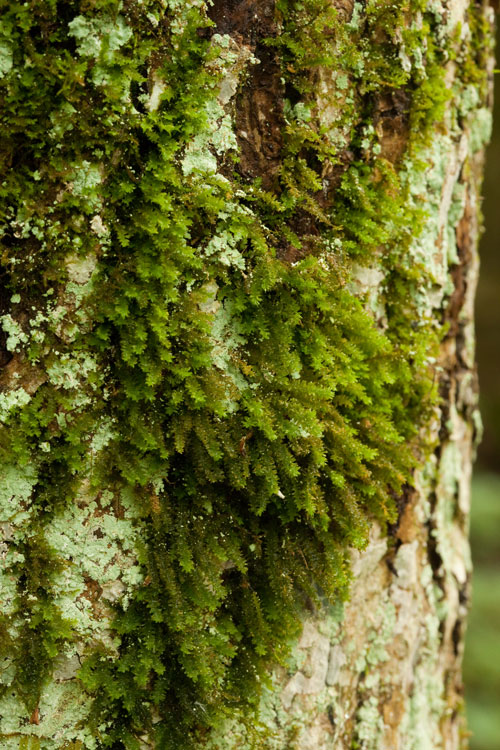
Anomodon minor. June 9, 2010. Delaware County, Ohio.

Anomodon minor. June 9, 2010. Delaware County, Ohio.
...and the branches, while
flattened, do not taper.
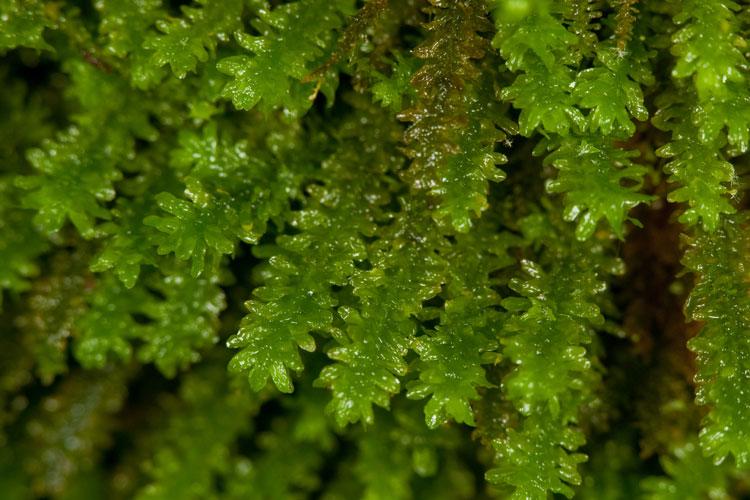
Anomodon minor. June 9, 2010, Delaware County, Ohio.

Anomodon minor. June 9, 2010, Delaware County, Ohio.
Through the microscope, the
identification is clinched. The tongue-shaped leavdes are very blunt,
without any terminal teeth.
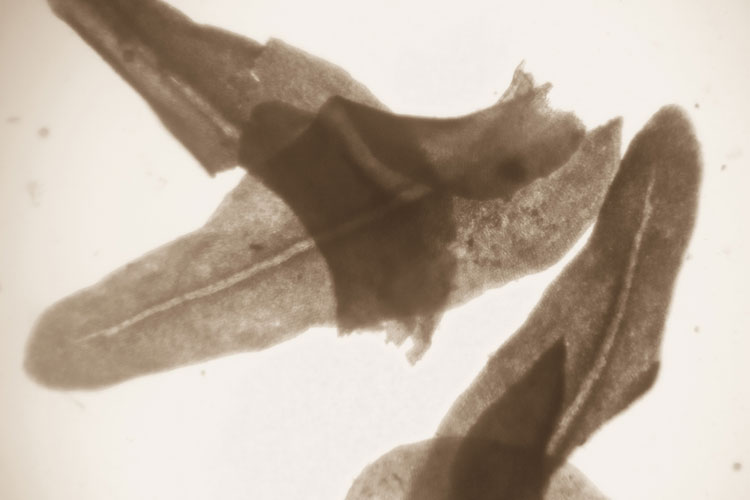
Anomodon minor leaves.

Anomodon minor leaves.
Along the road near the woods
is another plant whose genus begins with "A." and has 4 syllables. This
is woodland thimbleweed, Anemone
virginiana (Ranunculaceae, the buttercup family).
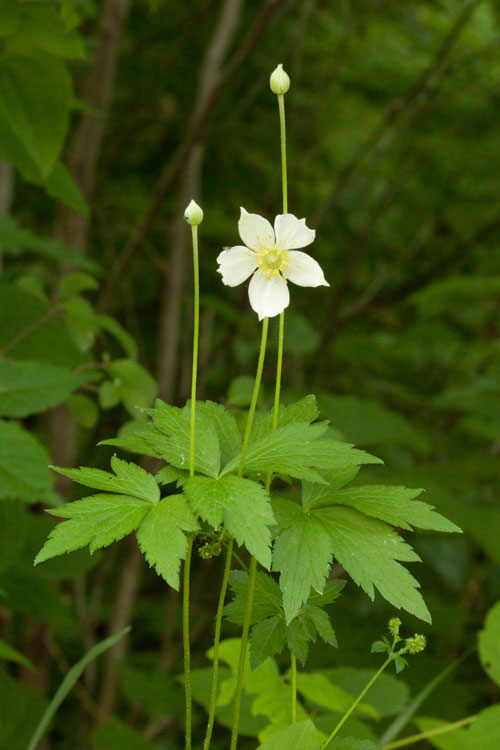
Woodland thimble-weed.
June 9, 2010. Delaware County, Ohio.
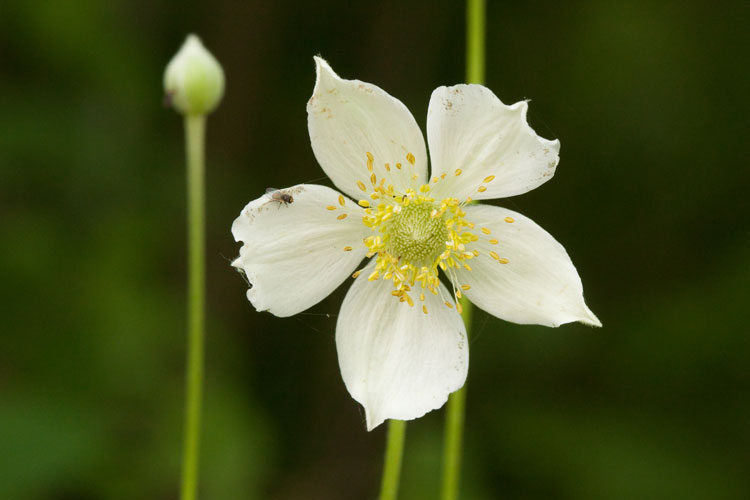
Woodland thimble-weed.
June 9, 2010. Delaware County, Ohio.

Woodland thimble-weed.
June 9, 2010. Delaware County, Ohio.
In typical buttercup fashion,
the thimble-weed flowers are radially symmetric, with numerous stamens
and numerous pistils, spirally arranged.

Woodland thimble-weed.
June 9, 2010. Delaware County, Ohio.
June 9-13, 2010. Delaware County, Ohio
In a lovely wooded area
alongside the Scioto River in Delaware County, Ohio is a little
limestone cliff covered with cryptogams. One of these is bulblet fern, Cystopteris bulbifera (family
Dryopteridaceae, the wood-fern family), seen here with mosses, mainly Anomodon attenuatus and Anomodon rostratus.
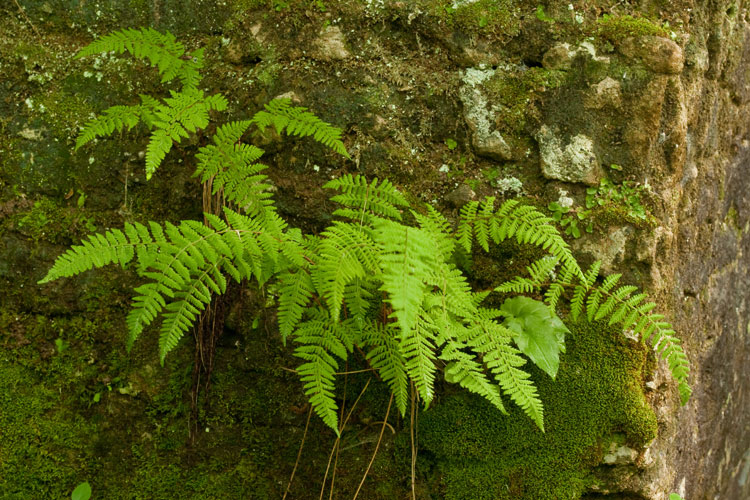
Cliff with bulblet fern. June 9, 2010. Delaware County, Ohio.

Cliff with bulblet fern. June 9, 2010. Delaware County, Ohio.
The moist limestone rock
habitat is a typical one for this fern. It may be distinguished from
afar by the long-attentuate shape of the fronds. Beneath, see that
these ferns are producing clusters of sporangia. Very beautiful
...isn't that a sight for sore eyes? Get it, "sore eyes ....sori"? Oh
well, anyhow, the sori (11 are shown in the photo below) are clusters
of tiny globe-shaped structures within which spores are produced. In Cystopteris, and indeed most fern
genera, the developing sori are covered by a flap
of tissue called the "indusium." The Cystopteris
indusium is hood-shaped. The common name "bladder fern" sometimes used
for members of this genus refers to the indusium shape.
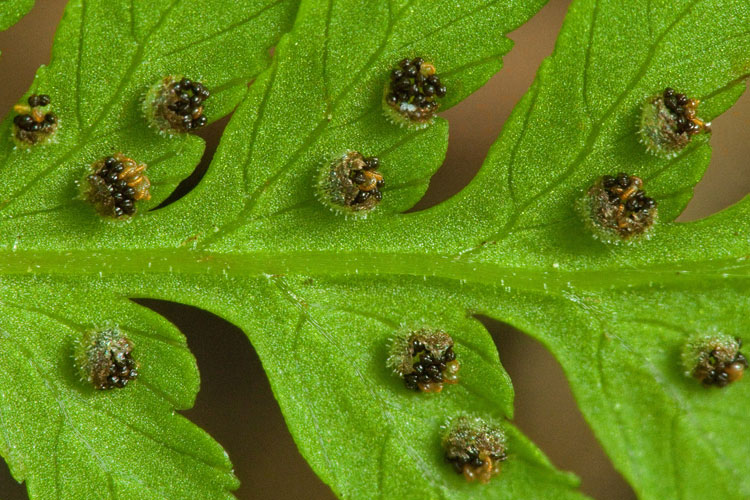
Bulblet fern sori.
In addition to reproducing sexually by spores, bulblet fern has an asexual means of making new plants that are clones of itself. These are pea-sized bulblets produced along the lower midrib.
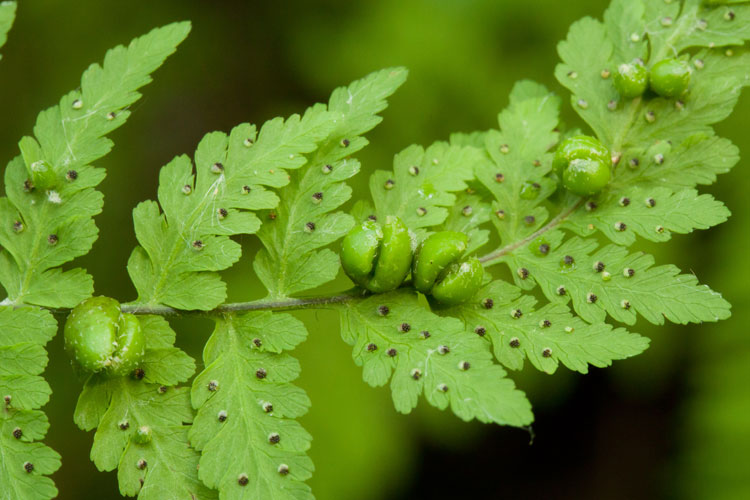
Bulblet fern bulblets

Bulblet fern sori.
In addition to reproducing sexually by spores, bulblet fern has an asexual means of making new plants that are clones of itself. These are pea-sized bulblets produced along the lower midrib.

Bulblet fern bulblets
Sharing the cliff with the
bulblet ferns is an orchard spider, Leucauge
venusta,
identified using the wondeful new "Common Spiders of Ohio" field guide
by Rich Bradley, published by, and available for free from, the Ohio
Division of Wildlife. Bradley tells us that this is a an orb-weaver,
but unlike most orb-weavers, it makes a horizontal, not vertical, web
(suggesting a relationship to another spider family, the long-jawed
spiders). Another unusual feature: the female's legs are green. In real
life she looked a lot more silvery that this photo shows.
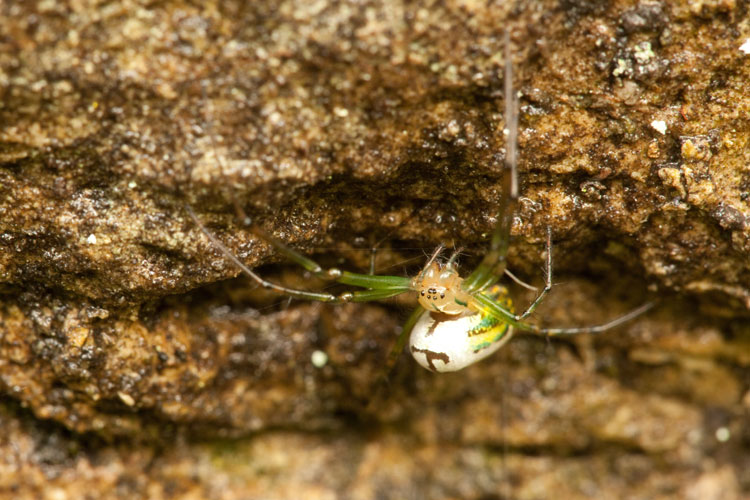
Orchard spider. June 13, 2010. Delaware County, Ohio.

Orchard spider. June 13, 2010. Delaware County, Ohio.
Another intruguing aspect of
the orchard spider is the presence of odd elaborate web-like
specialized setae on the base of the hind leg, seen as approx. 8
very faint curved parallel lines in the center of the zoom-crop image
below. Those are a part of her body, not her web; they are believed to
be a sensory adaptation.
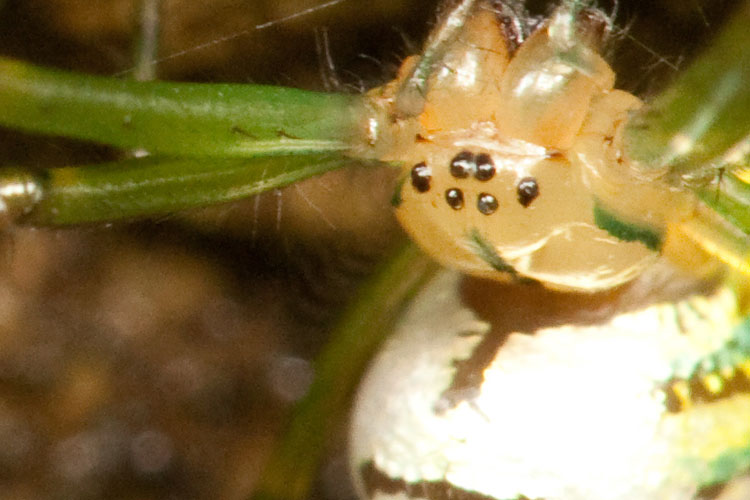

Modified setae on femora of
orchard spider. (Look closely.)
Ashland
June 8, 2010. Dublin, Ohio.
All of the trees visible in
this photo are ash (Fraxinus,
family Oleaceae, the olive family) trees along Blazer Parkway in
Dublin, Ohio. Considering the emarald ash borer, perhaps we should wish
the company were named "Oakland."

Ash trees along Blazer Parkway. Dublin, Framklin County, Ohio. June 8, 2010.
Graminoids 
Ash trees along Blazer Parkway. Dublin, Framklin County, Ohio. June 8, 2010.
Claridon Railroad Prairie
Caledonia, Marion County, Ohio. June 7, 2010
There are three families of
"graminoids": grass-like plants with linear leaves and small
wind-pollinated flowers These are: (1) grasses themselves (family
Poaceae), (2) sedges (Cyperaceae), (3) rushes (Juncaceae). All were in
evidence today at Clarison Railroad Prairie in Caledonia, Marion
County, Ohio.
Grasses have their minute flowers eveloped by wee little paired scales: (1) the outward-facing and usually larger lemma and (2) the inner, usually smaller palea. All together, the flower, lemma and palea constitute the "floret." Grass florets are often aggreated into tight little two-ranked spikes, appropriately called "spikelets," that are the actual grass infloresence. Note however that spikelets in many grasses are one-flowered, and also that the spikelets themselves are displayed in a secondary infloresence that gives grasses their distinctive looks from afar, with great variety among the various species. In fowl manna grass, Glyceria striata, the spikelets are 5-8 flowered, and they are disposed in a loosely wide-spreading branched panicle.
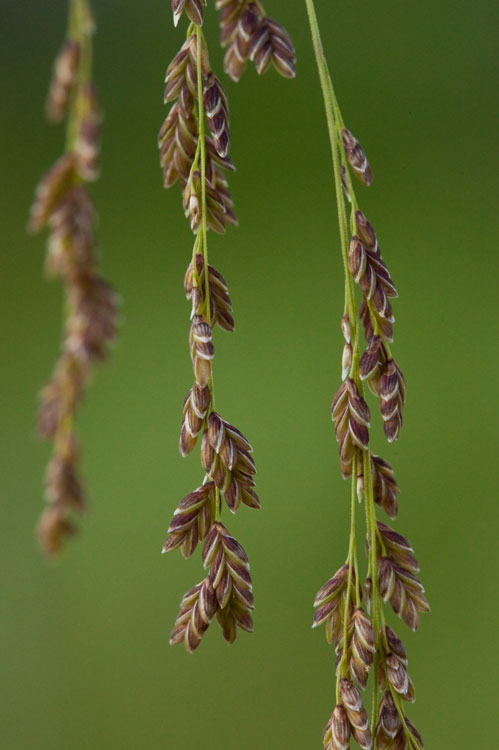
Fowl manna grass at Claridon Prairie. June 7, 2010.
Iris in the Key of E.
Claridon Railroad Prairie
Caledonia, Marion County, Ohio. June 4, 2010
Free Parking Weed Walk
OSU Columbus Campus, June 1, 2010
Grasses have their minute flowers eveloped by wee little paired scales: (1) the outward-facing and usually larger lemma and (2) the inner, usually smaller palea. All together, the flower, lemma and palea constitute the "floret." Grass florets are often aggreated into tight little two-ranked spikes, appropriately called "spikelets," that are the actual grass infloresence. Note however that spikelets in many grasses are one-flowered, and also that the spikelets themselves are displayed in a secondary infloresence that gives grasses their distinctive looks from afar, with great variety among the various species. In fowl manna grass, Glyceria striata, the spikelets are 5-8 flowered, and they are disposed in a loosely wide-spreading branched panicle.

Fowl manna grass at Claridon Prairie. June 7, 2010.
Here's a zoom-crop of a
portion of the manna grass panicle, showing details of the spikelets,
in the font that everybody loves to hate, Comics Sans! Note that each
spikelet includes, at its base, one additional pair of scale-like
appendage, both called "glumes." The lowermost (relative to the growth
axis of the plant, also called "proximal" first glume generally the
smaller of the two.
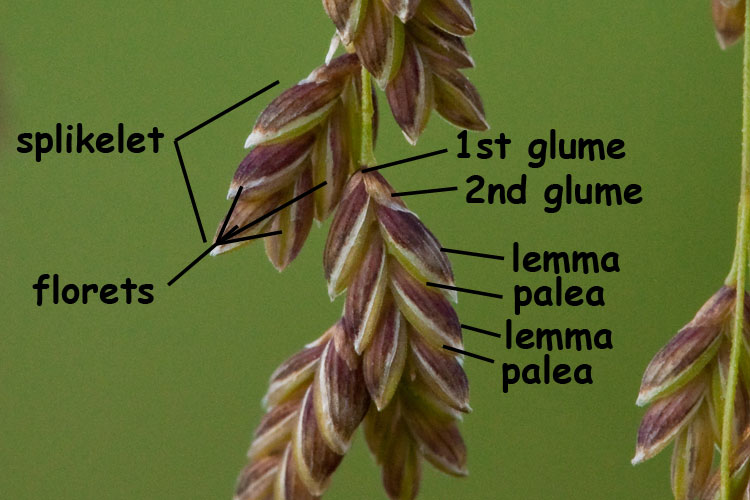
Manna grass spikelets.

Manna grass spikelets.
Sedges too have minute
flowers associated with little scales. Sedge scales, however, are not
paired as are those of grasses; they come one per flower, and are
indeed called "scales." In most sedge genera the florets are arranged
spirally in each spikelet. In the big genus Carex and many other sedges
the flowers individual flowers are unisexual (either male or female),
with both sexes on an individual plant (i.e., they are monoecious), and
there is substantial variation in the way they are disposed on the
plants. In Buxbaum's sedge, Carex
bubaumii, the spikelets are bisexual, with the staminate (male)
flowers beneath the pistllate ones. That is evident because, after
having released pollen, the male flowers leave little trace and so
appear and a constricted part of the spkelet owing to the now empty
scales, whereas the female ones are plumply in fruit. I'm really glad
the "Kompozer" doesn't have a spell-checker because I think that
"plumply" would have a little wiggly line underneath, and I'd have to
think of another word. Part of the plumpiness, plumposity, and its
plumpaceous nature is due to the presence of a unique Carex feature, the perigynium: a
bag-like structure that surrounds the actual fruit, which is a
one-seeded achene.
MOUSEOVER the IMAGE
for SPIKELET DETAILS
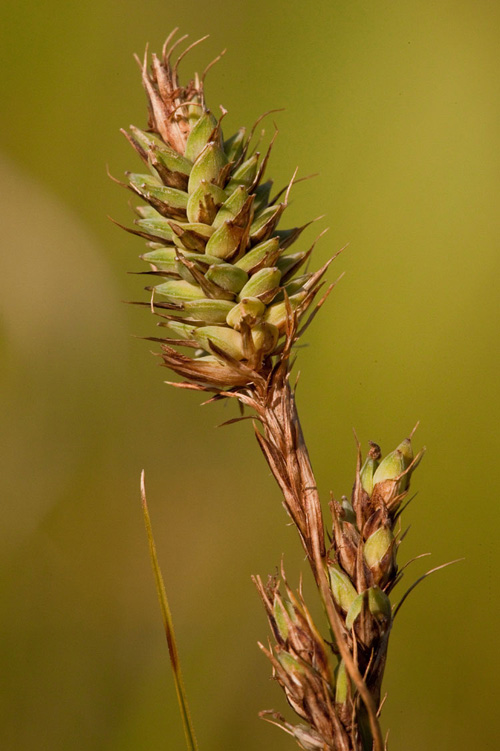

Carex buxbaumii at
Claridon Prairie. June 7, 2010.
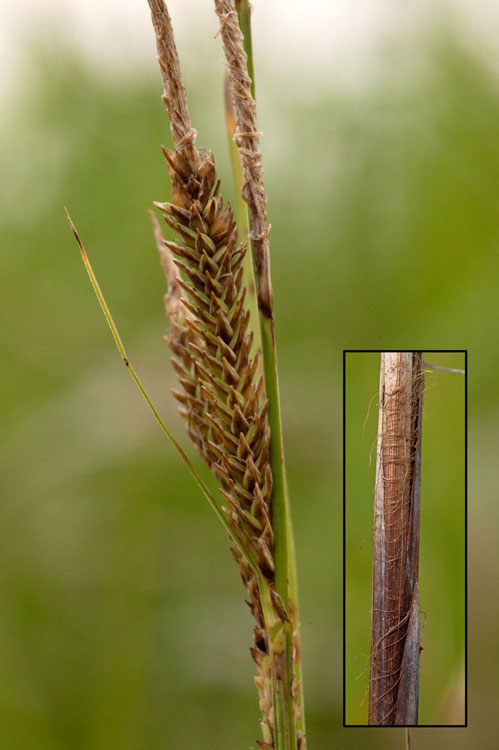
Tussock sedge at Claridon Prairie. June 7, 2010.
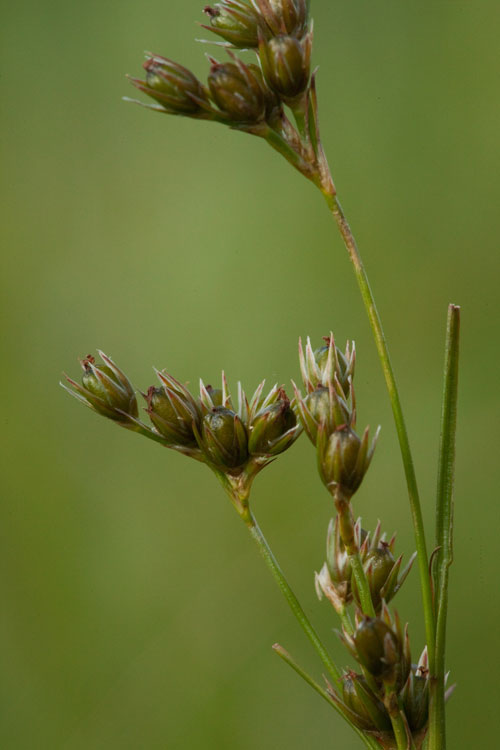
Path rush at Claridon Prairie. June 7, 2010.
MOUSEOVER IMAGE for details
Another carex that is
prominent here is tussock sedge, Carex
stricta. Tussock sedge
produces its male flowers in terminal spikelets that are entirely
staminate. The pistillate scales are a dark purple-black in the center.
Nice. Also, as it happens, one of the diagnostic traits of sedges in
this group is a feature of the basal leaf-sheath. Here the sheath is
seen to be frayed in a ladderlike fashion (inset).

Tussock sedge at Claridon Prairie. June 7, 2010.
The third graminoid family is
Juncaceae, the rushes. Rushes look
like tiny little lilies and
it would be nice if they were, but rushes are evidently not especially
close to lilies taxonomically. Nonetheless, radially symmetric
flowers with three sepals and three petals that all look alike, 6
stamens and a superior ovary with three chambers (carpels) that
develops into a capsule fruit type describes both rushes and lilies
pretty well. Here's path rush, Juncus
tenuis.

Path rush at Claridon Prairie. June 7, 2010.
Fortunately for insects in
search of nectar, not all the plants here are wind-pollinated. Wild
garlic, Allium canadense, at
least has a few flowers along with the bulblets in its umbel.
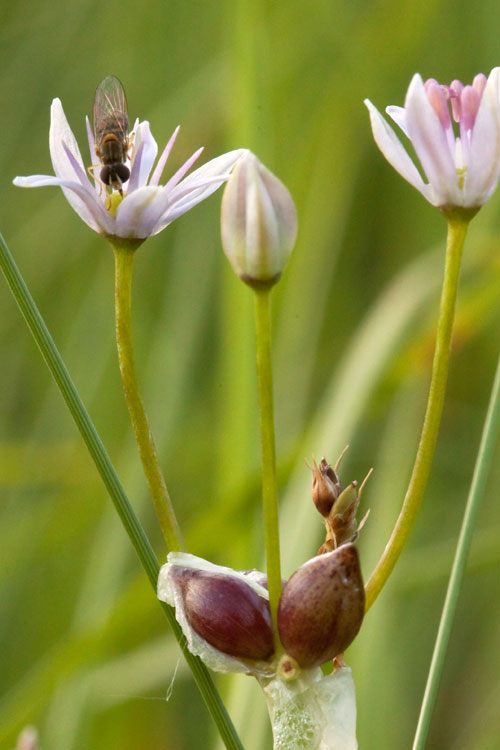
Wild garlic at Claridon Prairie.

Wild garlic at Claridon Prairie.
Iris in the Key of E.
Claridon Railroad Prairie
Caledonia, Marion County, Ohio. June 4, 2010
One of the best
prairie
remnants in the Sandusky Plains region of central Ohio is a narrow
strip of land squeezed between a little-used county road and an active
set of railroad tracks in Caledonia, Marion County Ohio. It's called
the Claridon Railroad Prairie. A wildflower that is conspicuous today
is a blue flag iris that I belive to be northern blue flag, Iris versicolor
(Iridaceae, the iris family). A few years ago I did a vegetation
survey of this tract. (A .pdf of the study results is available here.)
At that time I gave each species careful scrutiny. This one proved to
be quite a puzzler to identify with certainty, distinguishing between
northern blue flag and southern blue flag, I. virginica var. shrevei, formerly known as Iris shrevei. I still have some
doubts.
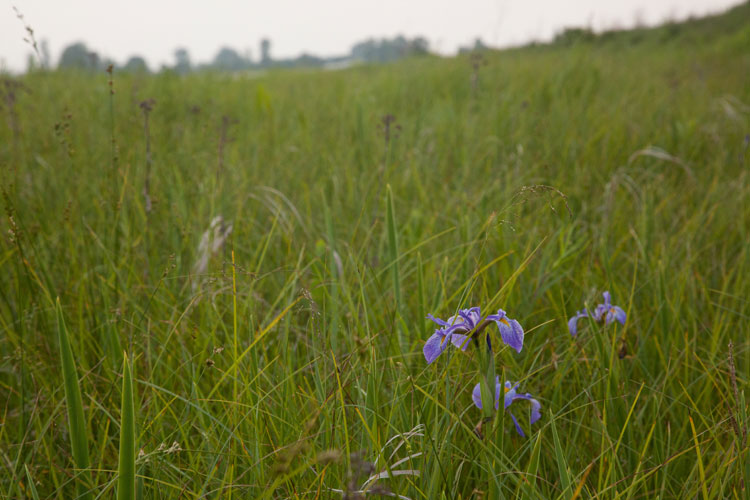
Iris at Claridon Prairie, Caledonia, Marion County, Ohio. June 4, 2010.

Iris at Claridon Prairie, Caledonia, Marion County, Ohio. June 4, 2010.
Based on range maps
in E. Lucy Braun's Ohio monocots book, it seems that northern blue
flag, indeed more northern, wouldn't be expected this far south,
whereas the southern blue flag that ranges across central Ohio is the
likely choice.
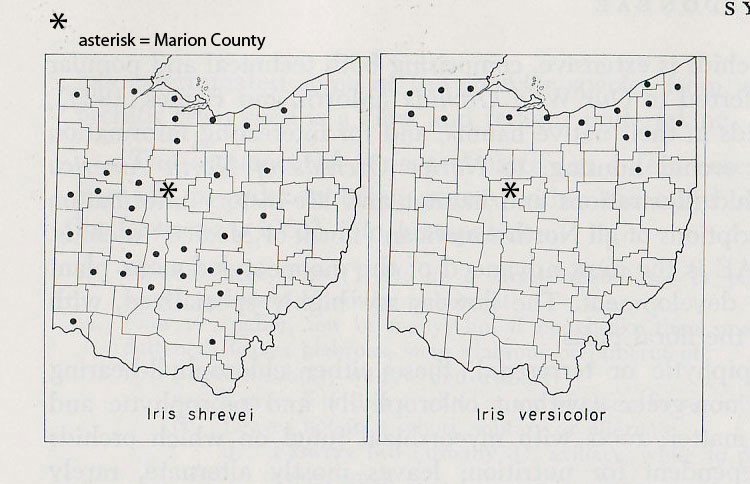
Iris range maps.
Looking at the actual plants, here's a closer view of the
iris, with a silver-spotted skipper visiting.
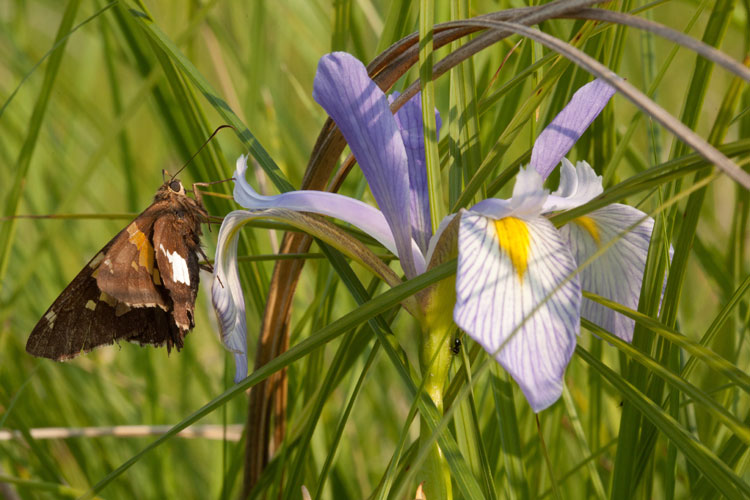
Blue flag with skipper at Claridon Prairie. June 4, 2010.

Iris range maps.

Blue flag with skipper at Claridon Prairie. June 4, 2010.
...and here's a shot showing
developing fruits, and ants visiting.
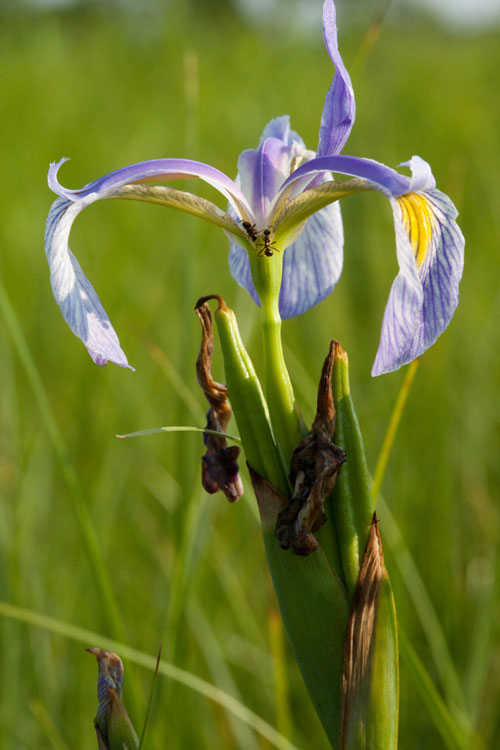
Blue flag with ants at Claridon Prairie.

Blue flag with ants at Claridon Prairie.
Iris flower structure is a
little weird; some details are explained here.
The main thing to keep in mind is that the biggest and brightest
appendages are the sepals. Here's the relevant couplet in E.'s key (the
key of E).

Iris in the key of E.

Iris in the key of E.
Looking at the key, and
looking at the plant, we see a fairly bright yellow blotch at the base
of the blade, hinting towards I.
shreveri/virginica.
But close examination of the blotch revealed it to be essentially
glabrous, so maybe it's greenish-yellow as well. The measaurements were
more in line with versicolor
too I seem to recall, as was also something to do with the shape of the
base of the style-branches, the significance of which is indicated in
this key, from Gleason and Cronquist's Manual of the Vascular
Plants...(1991, the New York Botanical Garden).

Iris in the key of G&C

Iris in the key of G&C
All-righty then, case closed.
The verdict: northern blue flag: Iris
versicolor. Ahh but wait. Ladies and gentlemen of the jury, I
bring as a witness the Iris
virginica schrevei page on the excellent and well-informed web
site Wetland
Wildflowers of Illinois
where a flower is illustrated that looks for all the world like our
suspect, especially considering the similarity of latitude and
habitat --The photograph was taken at a moist remnant prairie along an
abandoned railroad near Urbana, Illinois! They call attention
to the hairless nature of the yellow blotch, a character that the
afformentioned keys
associate with the northern one. Perhaps versicolor ranges more widely than
is generally believed, or, alternatively, that viginica/schrevei is more variable.
Interesting!
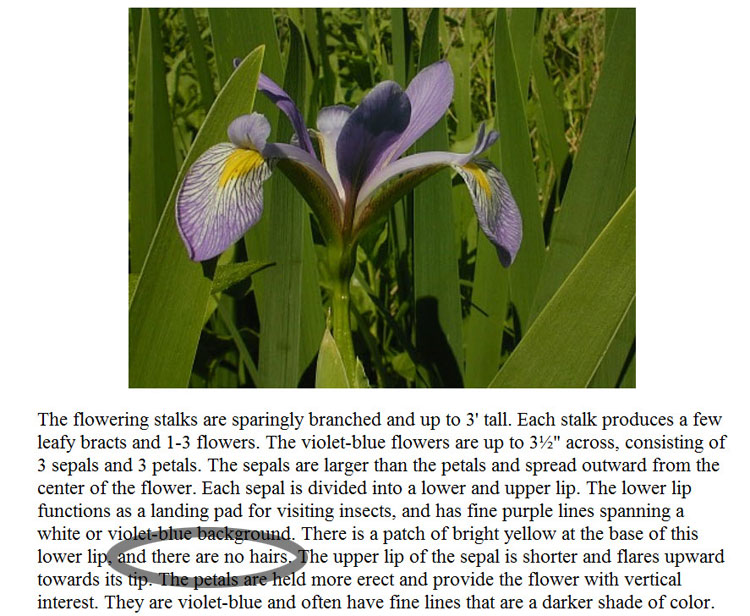
Iris virginia schrevei page of
Wetland Wildflowers of Illinois. (I added the elliptical annotation.)
SCREEN CAPTURE FROM EXCELLENT
WEBSITE

Iris virginia schrevei page of
Wetland Wildflowers of Illinois. (I added the elliptical annotation.)
Free Parking Weed Walk
OSU Columbus Campus, June 1, 2010
It's probably against the
rules, but to avoid paying for parking and also to get a little
exercise when I need to do something on the Columbus campus of OSU, I
park at a very public satellite facility of OSU that has "visitor
parking" about a mile from the building I need to be at. The walk is
pleasant and botanical.
Today the walking path is lined by motherwort, Leonurus cardiaca (Lamiaceae, the mint family) in flower. With its square stems, opposite leaves, sympetalous (i.e., having fused petals) bilaterally symmetric flowers clustered together into tight clusters (verticels) in the axils of the leaves, motherwort is instantly recognizable as a "mint."
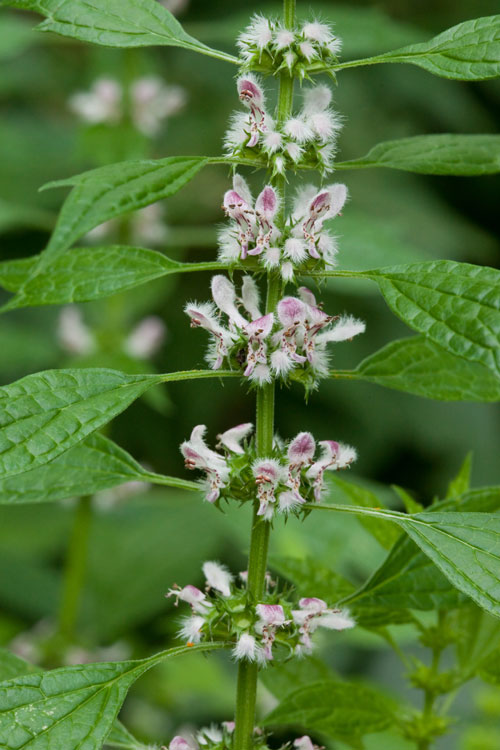
Motherwort. June 1, 2010. Columbus, Ohio.
Today the walking path is lined by motherwort, Leonurus cardiaca (Lamiaceae, the mint family) in flower. With its square stems, opposite leaves, sympetalous (i.e., having fused petals) bilaterally symmetric flowers clustered together into tight clusters (verticels) in the axils of the leaves, motherwort is instantly recognizable as a "mint."

Motherwort. June 1, 2010. Columbus, Ohio.
Motherwort, native to Europe,
is a well-known herbal plant that, as the comon name implies, has been
used for all conditions uterine --symptoms premenstrual, childbirthey,
post-partum,
menopausal, and the like, as well as for heart ailments (hence the
specific epithet "cardiaca",
an old generic name meaning "for the heart") The photo below shows a
hypertensive menopausal syrphid fly visiting a blossom.
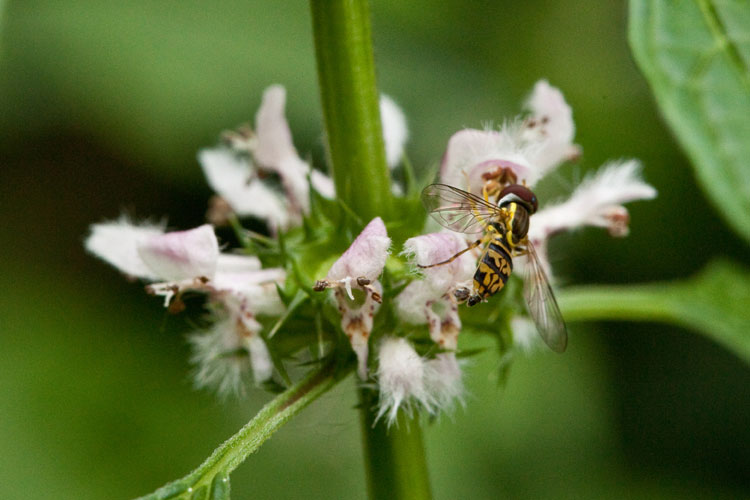
Syrphid fly visists motherwort in Columbus, Ohio., June 1, 2010.

Syrphid fly visists motherwort in Columbus, Ohio., June 1, 2010.
Nearby, a member of another
well-marked family, the mustard family (Brassicaceae). This is, I
believe, hedge mustard, Sisymbrium
officinale. The genus is an awful lot like Brassica,
from which it is distinguished technically, in part, by a minute
difference in the way in which the seed leaves (cotyledons) are folded
in the seed. Superficially, the hedge mustard flowers
are smaller, and the fruits narrower, than those of Brassica. The specific epithet "officinale" means
"of the apothecary" in reference to some medicinal use of the plant.
In this case, it has been used as a poison antidote, diuretic,
expectorant,
tonic, and laxative. Sometimes it almost seems that all herbal medicine
consists of using "___________" (fill in the blank with a
plant name, expecially one that ends in "wort") being used as a poison
antidote, diuretic, expectorant, tonic, or laxative.
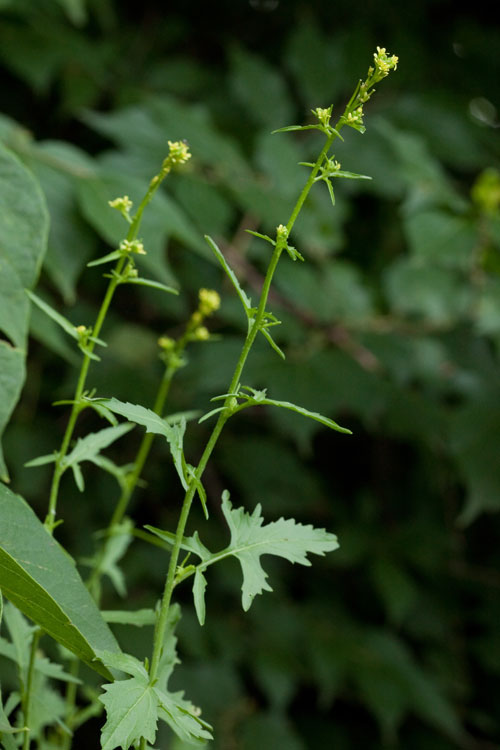
Hedge mustard in Columbus, Ohio. June 1, 2010.

Hedge mustard in Columbus, Ohio. June 1, 2010.

